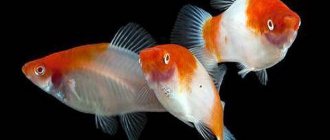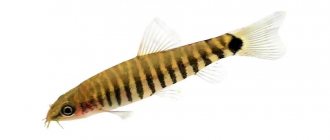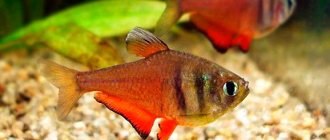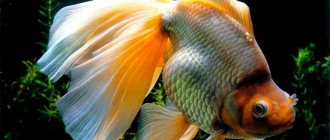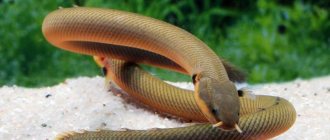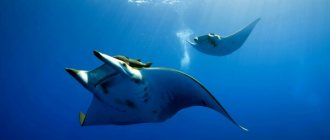Description
Adults reach an average length of up to 25 cm, although specimens over 40 cm have been recorded. The fish has a tall, disc-shaped body.
The color is silver with red hues along the edges of the body and fins. A characteristic feature is the presence of a vertical black stripe located in the middle of the body. Brief information:
- Aquarium volume - from 300 liters.
- Temperature - 24–28°C
- pH value – 6.0–7.0
- Water hardness - soft (up to 10 dH)
- Substrate type - any
- Lighting - dim
- Brackish water - no
- Water movement - weak to moderate
- The size of the fish is up to 25 cm.
- Nutrition - food based on plant components
- Temperament - peaceful
- Keeping in a group of 4–5 individuals
Myleus schomburgkii fish
The Myleus schomburgkii fish is native to South America. This is a fairly large and very beautiful fish, quite often found in the tributaries of the Amazon. In natural conditions it can reach up to 25 cm, in aquariums it is usually smaller.
Characteristics and external data
The body of the Mileus fish is disc-shaped, slightly elongated, the sides are squeezed. The silver color of the fish can be diluted with orange-yellow specks. A distinctive feature is the rather large eyes. Males look more colorful, but females are not particularly elegant. The fin has a special cutout at the anus, and the color changes to a more attractive one only during spawning.
Content
Mileus Schomburgka is a schooling type fish that is accustomed to a peaceful life. In order for her to feel as comfortable as possible, it is recommended to keep at least 5 pieces exclusively in flocks. However, it is necessary to add medium-sized fish, for the reason that small fish may well become food for the “moon”. It is imperative to choose a spacious aquarium with a volume of at least 300-350 liters. Permissible water temperature: 23−27 degrees. Water hardness: 4−8. Lighting should be diffused.
The use of aquarium vegetation is mandatory. Java moss can be used for such purposes, but remember to leave enough space for comfortable swimming. It is required to maintain optimal water parameters: hardness should be up to 10 degrees, and PH from 5.8 to 6.8, while the temperature should not exceed 27 degrees and be at least 23 degrees Celsius. Aeration should be plentiful.
At least 25 percent of the water will need to be replaced within a week. The fish's diet is varied; it consumes both plant and live food, including the possibility of using combined food.
Despite the fact that you can feed almost any food, most of the diet should be plant foods (spinach, fruits, or special food from well-known brands).
The fish can be considered sexually mature after 2 years. The fish is a long-liver and can live actively in an aquarium environment for up to 10 years.
Breeding offspring
In order for spawning to be possible, the aquarium must be at least 200 liters. Spawning is a rather complex process, so temperature conditions must be observed, so the water should have a temperature of 23 to 27 degrees. It is important to maintain hardness - 5−7.2 Ph. The aquarium used for spawning should be planted with plants, and dark soil should be laid out on the bottom.
Sufficiently bright lighting is used. Before spawning, the fish should be kept separately from the rest and actively fed. After this, 2-3 males and 5 females are transplanted into an aquarium environment. During the entire spawning period, females are able to lay about 500-600 eggs. Despite its apparent simplicity, breeding this fish in such aquarium conditions is not always successful.
Maintenance and care, arrangement of the aquarium
The optimal aquarium size for a flock of 4–5 fish starts from 300 liters. Mileus Schomburgka are excellent swimmers and require large open areas for swimming. However, in the design it is also important to provide places for shelter, for example, from natural driftwood (branches, tree roots).
They can jump out of the water, so having a tight lid is welcome.
Being a predominantly herbivorous species, most ornamental aquarium plants are likely to be eaten or severely damaged. It is recommended to use artificial substitutes, or use fast-growing plants with hard leaves, such as anubias, hornworts and others.
Maintenance will require the aquarist to establish and maintain low pH and dH values. Regularly replacing some of the water with fresh water (together with cleaning the soil), along with the uninterrupted operation of the filtration system, will prevent the accumulation of excess amounts of organic waste.
Nutrition
The basis of the diet should be plant-based food. These can be commercial products in the form of dry flakes and granules made from seaweed, vegetables and fruits, as well as pieces of cucumber, zucchini, lettuce, spinach, green peas, etc.
It is important not to limit yourself solely to plant-based products. It is necessary to combine with regular food (in small quantities), for example, flakes for American cichlids containing protein components, or periodically feed live or frozen brine shrimp and bloodworms.
On occasion they may eat smaller fish.
Mileus-luna (Myleus rubripinnis luna): maintenance, breeding, photos, videos.
General information on Myleus rubripinnis luna:
Family: Characidae Origin: South America, Amazon River basin. Water temperature: 23-26 Acidity: 5.8-7.0 Hardness: 4-8 Maximum size in the aquarium: 15-20 Habitat layers: average Minimum recommended aquarium volume for a flock of 5: at least 250 liters
Living conditions
The mileus moon can be found in the Amazon River, which flows through South America.
Appearance and gender characteristics
Mileus-luna has a slightly elongated disc-shaped body, squeezed at the sides. It is painted silver and strewn with yellow-orange spots. The eyes of this fish are large in size. The female mileus luna has a more modest coloring than the male, whose fin at the anus has a notch, and the body color becomes much brighter during the spawning period. Mileus luna can be classified as a fairly tall fish, because its height can be 12 cm.
Conditions of detention
Mileus luna is a schooling, peace-loving aquarium fish. It is best to keep it in a small flock of at least 5 individuals. Any large or medium-sized fish will be suitable as neighbors; small fish can be easily eaten by it. The volume of the aquarium for keeping the mileus luna should be at least 200 liters in size. It should be planted with aquarium plants, Thai fern or Java moss are good, but be sure to leave enough free space for swimming. Coarse sand or fine gravel can be used as soil. Optimal water parameters for keeping: hardness up to 5°, pH 5.8-6.8, temperature 23-25°C. Ample aeration, good filtration and weekly water changes of up to 20% of the aquarium volume are also recommended. Mileus luna feeds on both plant food (spinach, nettle leaves, fruits, dandelion, lettuce) and live food; a combination can be given.
feed the mileus luna with almost any live and combined food, but preference should be given to plant foods (scalded leaves of nettle, spinach, lettuce, dandelion, cucumbers, algae).
The mileus luna reaches sexual maturity The lifespan of this fish is about 10 years.
Breeding
The spawning aquarium for the mileus luna must be at least 200 liters in volume. The water temperature required for spawning is 23-27 degrees. Desirable water hardness is pH 5.0-7.2. The spawning aquarium is planted with plants and lined with dark soil. Lighting for spawning requires bright light. Before spawning, the spawners are kept separately and fed generously. Then a group of 2 males and 5-6 females is transplanted into the spawning aquarium. The female lays up to 600 eggs. At 5-6, the young begin to swim and take food. Unfortunately, breeding the mileus luna in aquarium conditions has not been very successful to date.
Piranhas
Piranhas: The family of freshwater ray-finned fish belongs to the order Characinidae, and lives in various bodies of water in South America. These fish are characterized by powerful jaws and sharp teeth. Today, the piranha family includes 16 modern genera and 95 species. (Wikipedia)
We can safely say that piranha is one of the most famous fish in the world! There are many legends and myths about piranhas, but not all horror stories are true. These fish can pose a real danger during the dry period, when water bodies dry out greatly and they begin to lack food. Piranhas first eat all the fish belonging to other species in this reservoir, then they begin hunting each other.
|
Moreover, they are quite shy and therefore gather in flocks to protect themselves from predators. And in nature they have enough enemies: these are freshwater dolphins, Amazonian otters, various representatives of the cat family caimans, herons, arapaima - an ancient fish of a very unusual shape.
The famous teeth , relative to the size of the body, are quite large, have a conical shape; when closed, the upper rows fit tightly into the spaces between the lower ones, so that there is no room for a gap; in addition, the jaw muscles of piranhas are very strong.
Redfin myleus (Myloplus rubripinnis)
Redfinned mileus (mileus), or mileus moon, or mileus rubripinnis (Redhook myleus) is a herbivorous fish native to South America. These are quite active schooling fish, which require an aquarium of 250-500 liters to keep. They are demanding on the quality of water and feed. They can bite very painfully . Keep in species aquariums with other peaceful fish. Breeding in aquariums is quite difficult.
Habitat: South America - Amazon River basin (Ecuador, Venezuela, Colombia, Guyana, Suriname, French Guiana, Peru and Brazil). Habitat: shallow water, densely overgrown with vegetation. Description: body disc-shaped, slightly elongated in length. The head is small, the eyes are large. The tail fin is two-lobed. The pectoral fins are small. The anal fin is large, hook-shaped. The jaws are powerful with strong, strong teeth. Mileus bites are quite painful! Color: the main background of the body of adult fish is silver. The fins are translucent. The anal fin is red with a black edge. Juveniles are a rich coffee-brown color. Size: in nature it grows up to 39 cm and weighs up to 2.5 kg. In aquariums it is much smaller - up to about 15-20 cm. Life expectancy: up to 10 years.
Aquarium: species aquarium, tightly closed with a lid on top. Dimensions: minimum size - 250 liters for a school of 5-6 adult fish (180x37.5x37.5 cm). The optimal size for the same amount of fish is from 500-600 liters. Water: pH 5.8-7, dH 4-8°, water should be peat, free of nitrogen compounds. Powerful aeration, filtration, low flow. Weekly changes of up to 15-20% water. Mileus are demanding on the quality of water and food. Temperature: 23-26°C. Lighting: diffused. The duration of daylight is at least 10-12 hours.
Related article Interesting facts about sharks
Soil: coarse sand or fine gravel. Plants: All soft-leaved plants will be eaten, so artificial or hard-leaved plants (Anubias, Bolbitis, Cryptocoryne, Thai fern and Java moss) are used to decorate the aquarium. Decoration: driftwood, roots, stones, decorative objects (ships, castles, grottoes, etc.), thickets of plants. Requires a lot of free space for swimming.
Feeding: vegetable (spinach, fruits, nettle leaves, dandelion, lettuce, steamed oatmeal, chopped green peas and canned corn), as well as a variety of live and combined foods.
Behavior: Mileus are active schooling fish that are best kept in a group of at least 6-10 individuals. Personality: peaceful, timid. When frightened, they begin to rush around the entire aquarium, which can lead to various injuries. Water zone: upper and middle layers of water. Can be kept with: peace-loving large to medium-sized fish. Cannot be kept with: small (less than 5 cm) and slow-moving fish.
Mileus luna (Myloplus rubripinnis luna)
Breeding fish: in aquarium conditions is problematic. Group spawning (with a predominance of females), in a separate aquarium. Spawning tank at least 150 cm long, brightly lit, with a dark bottom. Before spawning, the spawners are removed and fed generously. Water parameters: pH 5.8-6.8, dH up to 4°, temperature 23-27°C. Spawning occurs among thickets of plants. Sexual differences: the anal fin of the male is notched and has a longer outer ray.
Related article Piranha (Pygocentrus nattereri)
Puberty: occurs around 2 years of age. Quantity of caviar: up to 600 eggs. Offspring: fry begin to swim at 5-6 days.
Comments: a subspecies of the red-finned myleus is sold in pet stores under the name “mileus luna” (Myleus rubripinnis luna), which differs from the nominate species by the presence of yellow-orange spots on the body. The local population eats these fish.
Piranhas in an aquarium
The most common guest species found in aquariums include:
|
Piranha pacu
Pacu are piranhas, which, despite their menacing appearance and impressive jaw apparatus, are not at all so scary, because they are vegetarian piranhas . Under this name, scientists unite several species of South American freshwater piranhas, which prefer primarily plant foods in their menu.
They have unique teeth, slightly similar to human ones. Such teeth serve the paku for crushing nuts and seeds and eating other tough plant foods rich in fiber.
However, if you keep a pacu in the aquarium, you still need to be extremely careful so that the fish do not accidentally bite your hand when you, for example, clean the aquarium.
Mileus redfin or Mileus moon
Mileus are fairly large, peace-loving fish that live in schools. Their distribution area is the Amazon Basin, various bodies of water in Guiana and Suriname. Under natural conditions, mileus can grow up to 35 cm, in artificial conditions - up to 15 cm. Life expectancy - up to 10 years. Mileus are considered to be unpretentious fish species, so they are perfect for beginners and inexperienced aquarists. In artificial conditions it grows up to 15 cm.
Mileus get along quite easily in an aquarium with other types of fish. Since plants constitute their natural diet, it is not recommended to use live vegetation when decorating. Inanimate objects are much better suited, although some types of plants are suitable, for example, Thai fern or Java moss, since most herbivorous fish do not eat them. Despite their plant-based food preferences, mileus still need a protein component in their diet, so they should also be supplemented with live food, for example, bloodworms.
Red pacu
Red pacu Colossomabidens (two-toothed). Habitat - South America, mainly in the Amazon and its tributaries, people use it as a commercial fish (and who, in this case, eats whom?).
|
Despite its striking similarity to the piranha, the red pacu rarely includes meat in its diet (perhaps due to the small number of teeth?). In nature, their main diet is a variety of freshwater plants. Young fish grow quite quickly: in the first year, a red pacu can reach 30 cm in natural conditions. The maximum length of adult fish reaches 80 cm with a weight of 25 kg; it is extremely difficult to achieve such indicators in an aquarium. The maximum recorded lifespan in an aquarium is 28 years.
Red piranha
The red piranha (Rooseveltiellanattereri) has a red coloration on the ventral area only when young. In the natural environment it grows up to 30 cm (in an aquarium - no more than 20 cm with a weight of up to 1.5 kg) - a fairly large fish, olive-silver with a reddish or purple tint, on the back there are bright highlights, a dissected tail with a blue-green bordered, belly with a pronounced orange tint (fry have noticeable black spots that disappear with age). The body is relatively high, laterally compressed, the head has a large jaw, “like a bulldog.” It has a large mouth with very sharp conical teeth, with jagged edges, the upper ones fit tightly into the gap with the lower ones. The chest, as well as the base of the pectoral and anal fins, are painted bright red, the sides with gilded dots. In general, the color of the red piranha is very attractive! The lifespan of red piranhas in an aquarium is from 6 to 15 years.
Conditions in the aquarium
Piranhas are schooling fish and require large, elongated aquariums to be kept. So, for example, in an aquarium 500 liters. It is recommended to keep 7 fish. Piranhas love well-purified, aerated water.
|
Therefore, the filtration system must be selected taking into account the increased load on the biofilter; it is better to install an external filter with a double reserve of the volume indicated by the manufacturers. Water temperature 25 – 27°C, pH 5.8 – 7. Hardness: 2 – 12 dHG. Regular, at least once a week, water changes are required, at least 20%. Since piranhas are shy fish (who would have thought!), the aquarium should have enough natural shelters: stones, grottoes, tufts of vegetation.
|
You can feed piranhas with frozen, lean sea fish without bones, after defrosting it and draining the water, finely chopped shrimp, squid, beef heart and liver. Piranhas will happily chew on a mussel or eat an earthworm or maggot. It is when eating that their famous unbridled character manifests itself!
Mileus Schomburgka, Disc Tetra or Mileus Ribbon. Contents of Mileus Schomburgk.
Myleus schomburgkii, also called Myleus schomburgkii or Disk Tetra, can grow to very large sizes (adults of these tropical fish reach 42cm or 16 inches). In an aquarium, their length usually does not exceed 20-22cm. Therefore, if you are planning to keep these beautiful characin fish at home, then...
Myleus schomburgkii , also called Myleus schomburgkii or Tetra , can grow to very large sizes (adults of these tropical fish reach 42cm or 16 inches). In an aquarium, their length usually does not exceed 20-22cm. Therefore, if you plan to keep these beautiful characin fish at home, then you will need a very large aquarium with plenty of hiding places.
Mileus Schomburgk are known to have strong, powerful jaws with sharp teeth, so these fish can bite quite hard. From this it follows that when cleaning an aquarium with adult Disc Tetras, you must behave as carefully as possible.
Schomburgk's Mileus are usually sold as fry or small juveniles. However, given the potentially large size of Disc Tetras as adults, experts recommend not buying them unless you have a very large aquarium.
Mileus Schomburgka – photo.
Mileus Schomburgka - video.
Mileus Schomburgka - contents.
Scientific name: Myleus schomburgkii (Mileus Schomburgka).
Other names: Disk Tetra, Disk Pacu, Black Band Myleus, Band Myleus, Pampano.
Level of care for Mileus Schomburgk: easy.
Size: up to 42cm (16 inches).
Water parameters:
- t0: 23-270С (73-800F)
- pH 5-7
- dH hardness: up to 100
Mileus Schomburgk live in aquariums for 8-10 years, but often longer.
Origin of Disk Tetras: South America, river basin. Amazon, Nanay River, upper Orinoco River basin.
Temperament: Schomburgk's Mileus are schooling fish. They grow quite large, so they should be kept with similar-sized fish species and always in a large aquarium.
Breeding Mileus Schomburgk: They lay eggs, but due to their potentially large size, Disc Tetras are practically not bred at home. They come to fish stores from wild conditions or from specialized farms.
Aquarium sizes: for one pair - at least 150-200 liters, but since Schomburgk's Mileus are schooling, you will need a 600-800 liter aquarium to keep 8 fish.
Compatibility of Schomburgk's Mileus: Keep them with similar sized fish species that have similar water requirements.
Diseases of Mileus Tapeta: symptoms and treatment.
Food/Diet: In the wild, Tapeworms eat small fish, crustaceans, snails, fruits, etc. At home, they are given high quality food, such as pelleted food, as well as live or thawed freshwater fish food.
Region: middle and lower levels of the aquarium.
Gender: outwardly, males of Schomburgk's Mileus are no different from females.
Similar species: characins.
Cost: The fish are quite rare and expensive. You can buy Mileus Schomburgka for $18-25 per piece.
